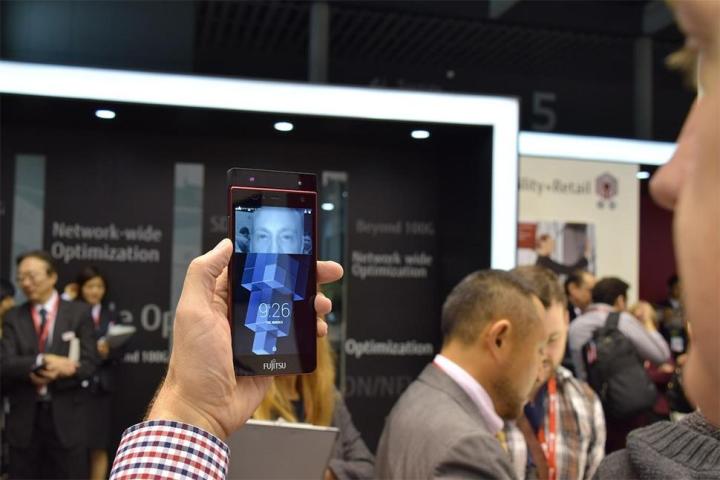
While not every technology is destined to make it to our devices, most of these companies are in the process of getting the new tech on next-generation smartphones. Here are five of the most amazing ones we got to try out in real life.
Qualcomm Snapdragon Sense ID
Fingerprint scanners may be old hat by now, but Qualcomm’s Sense ID is entirely different from Apple’s Touch ID or Samsung’s fingerprint sensor. Sense ID uses ultrasound to actually penetrate the outer layers of your skin to see inside the ridges and specific characteristics that make up your fingerprint. It can even see the sides of the ridges, identify your skin’s sweat pores, and detect whether the fingerprint is attached to a living human, by checking on blood flow. The end result is a very accurate, highly secure fingerprint scanner.
It read our fingerprints quickly and accurately, showing us all the details of our unique index finger print. To make it even more appealing, Sense ID can be embedded in any part of your phone because it can read your fingerprint’s details through glass, metal, or plastic — the three most common materials that cover smartphones. Qualcomm told us that Sense ID is set to debut in the next generation of Android smartphones with the Snapdragon 810 processor onboard, with some arriving as early as this year.
Delta ID ActiveIRIS Technology
If you aren’t impressed by fingerprint tech, maybe iris scanning will catch your imagination. Fujitsu recently partnered up with Delta ID to learn how to verify peoples’ identities with a scan their irises. The ActiveIris hardware is miniature, so it can be embedded in any smartphone. The technology consists of a LED light and infrared camera, which read the patterns of your iris to retrieve the “password.” Setting up ActiveIRIS on your phone is easy, as users simply create “templates” of both eyes by taking a photo. The templates are stored on the phone and users’ eyes can be recognized from up to 50 centimeters away, with or without glasses.
We tried it out a couple of times, using a Fujitsu phone, and found it dizzyingly quick to recognize our eyes, even while we were wearing glasses. Sadly, Fujitsu didn’t say when Delta ID’s tech would be incorporated into one of their phones, although they hinted that everything’s ready to roll. We expect to see Iris scanners on more devices relatively soon.
EyeVerify Eyeprint ID for ZTE Grand S3
In fact, iris scanning tech is already on one device from ZTE, the Grand S3. ZTE’s tech comes from EyeVerify, and it uses the unique blood vessel patterns and retina of your eye to unlock the phone. A swipe down on the lock screen accesses the eye scanner, which uses the 8-megapixel front-facing camera on the phone. A luminous green scanning line – straight out of sci-fi — rises and falls over a letterbox image of your eyes, as the camera checks to see if it matches what’s on file. If it does, you’re directed immediately to the home screen. The process takes about a second, making it faster than pattern unlock, and about the same as a well-learned passcode.
ZTE will sell the iris scanning phone in China and perhaps Europe for around $500 unlocked. Of course, we could very well see this tech transcend the Grand S3 and reach other ZTE phones as well. With any luck, one of the phones with this cool tech will come to the States.
Hoyos Labs 1U biometrics app
Hoyos Labs is a really intriguing startup that currently has an app (available for iOS and Android) called 1U, which uses facial recognition to identify the user. It’s currently used to unlock various password-protected sites from Facebook and Instagram, to Gmail and your bank account. The app asks you to take a photo of yourself using the phone’s camera to set it up. After that, you simply hold your phone in front of your face, position it, and the site you’re trying to access should unlock quickly.
If you want to add more security, so as to ensure that the app isn’t fooled by high-resolution photos of your face, you can set animation preferences. The app will them ask you to move your head this way and that, to confirm that you’re alive. We saw a demo of it recently, and were impressed by how quickly it worked. The company also has an ATM set up that uses facial recognition to determine your identity so you can withdraw money. This futuristic tech could be used to unlock your phone, or any number of other applications. Hoyos Labs told us that it’s in talks with big-name companies over a deal to get this tech in ATMs and devices everywhere.
Elliptic Labs ultrasonic touchless gesturing
Elliptic Labs isn’t really in the business of unlocking your phone, but it’s ultrasound-based gesture sensing tech could be used to do any number of things. The company is in talks to license its tech to manufacturers, so anything is possible at this point. We saw a number of demos, including the ability to snap a selfie with a swipe of your hand, wave away your alarm to send it to snooze, and guide a jellyfish through an obstacle course of plastic bags in a game. When we tested it, the tech was super responsive, even from a great distance of about three feet.
Here’s how it works: A modified chip inside the phone tunes the speakers to emit ultrasound waves, which then bounce off your hands, and are picked up again by the microphone. The rebounding signals are interpreted as hand motions, which relate to corresponding gesture controls. Of course, since Elliptic Labs needs access to the chip inside the phone itself, manufacturers will have to get onboard first. However, the company said that won’t be a problem, as several are already signed up, and the tech may hit phones as early as this year.


